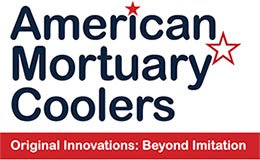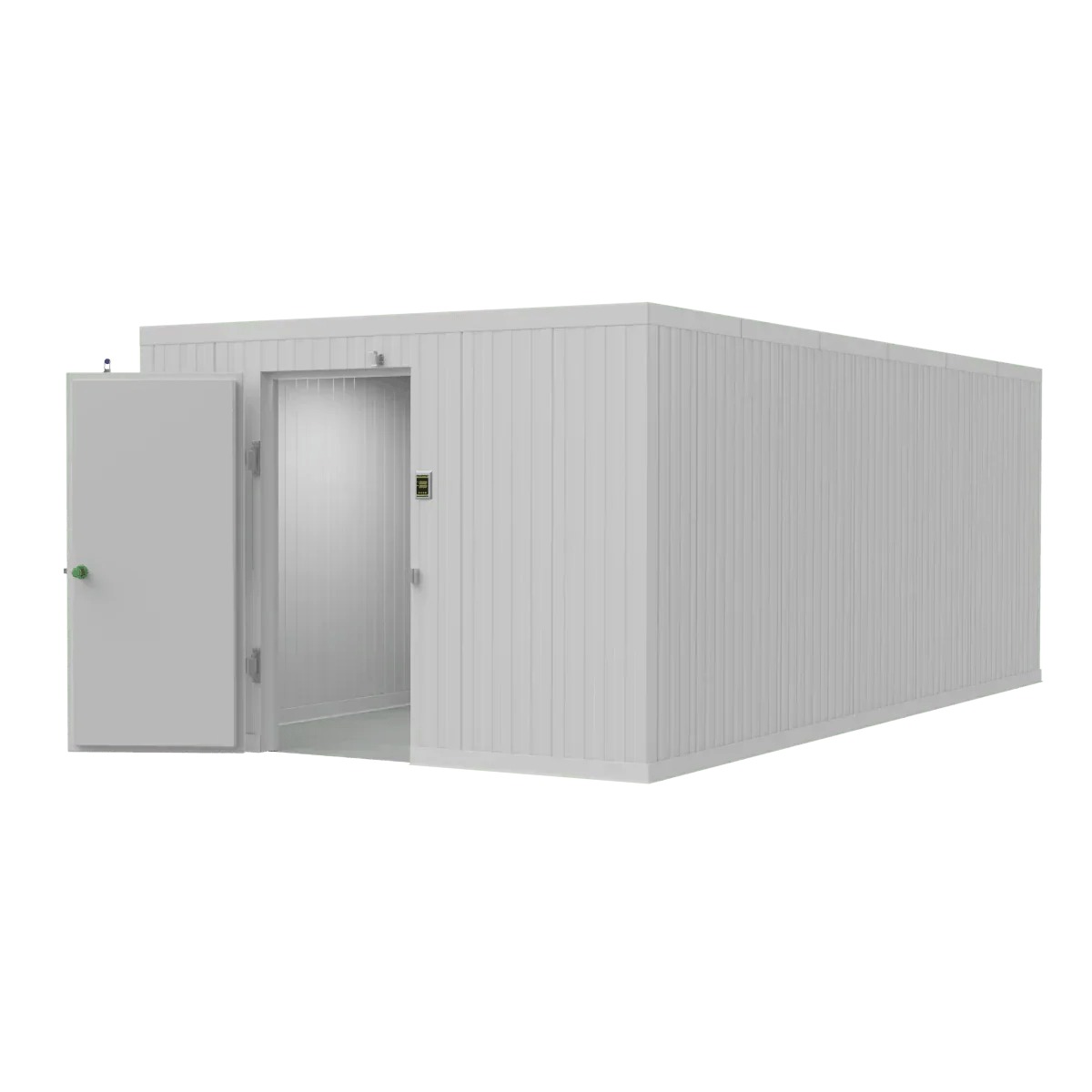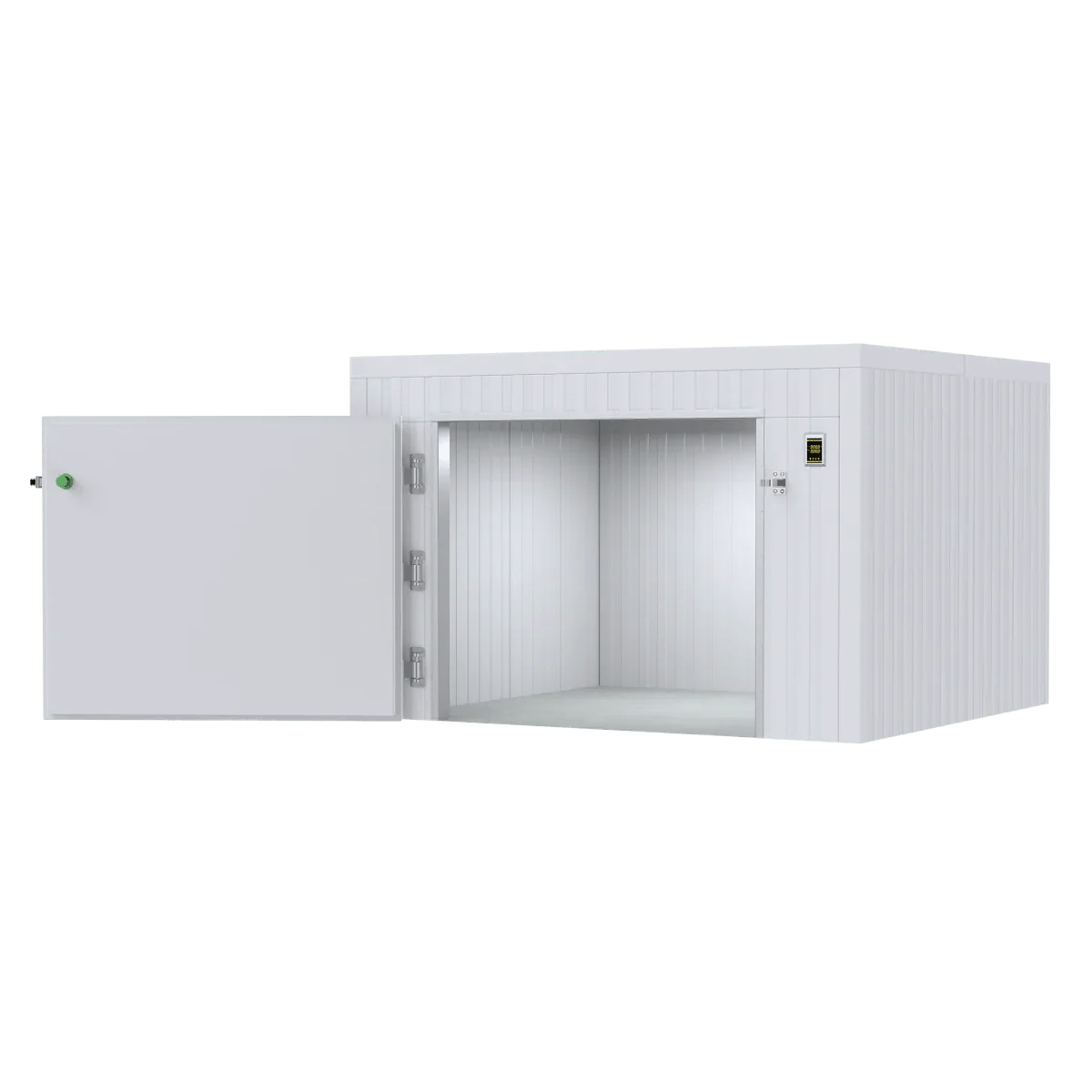Why Proper Cadaver Storage Matters for Your Facility
Cadaver storage racks are specialized equipment designed to safely store and organize deceased bodies in morgues, funeral homes, hospitals, and medical facilities. These systems maximize vertical storage space while ensuring safe, dignified handling of remains.
Key Types of Cadaver Storage Racks:
- Stationary racks - Fixed installations with 2-5 tiers, supporting up to 300 lbs per level
- Mobile racks - Wheeled units with locking casters for flexible placement
- Collapsible racks - Quick-deploy systems that set up in 60 seconds for surge capacity
- Roller racks - Feature ball-bearing rollers for easy one-person body transfers
- Cantilever racks - Open-access design without center posts for easier loading
Loading Orientations:
- Side-loading - Bodies slide in from the side, ideal for narrow spaces
- End-loading - Bodies load from the end, requires more aisle width
- Multi-directional - Can load from multiple angles for maximum flexibility
Modern facilities face increasing pressure to handle capacity surges efficiently. Portable mortuary storage racks can increase storage capacity by up to 400% in existing cooler spaces, while collapsible systems provide rapid deployment during mass fatality events.
I'm Mortuary Cooler from American Mortuary Coolers, where we've supplied cadaver storage racks and cooling systems to funeral homes and medical facilities nationwide for over a decade.
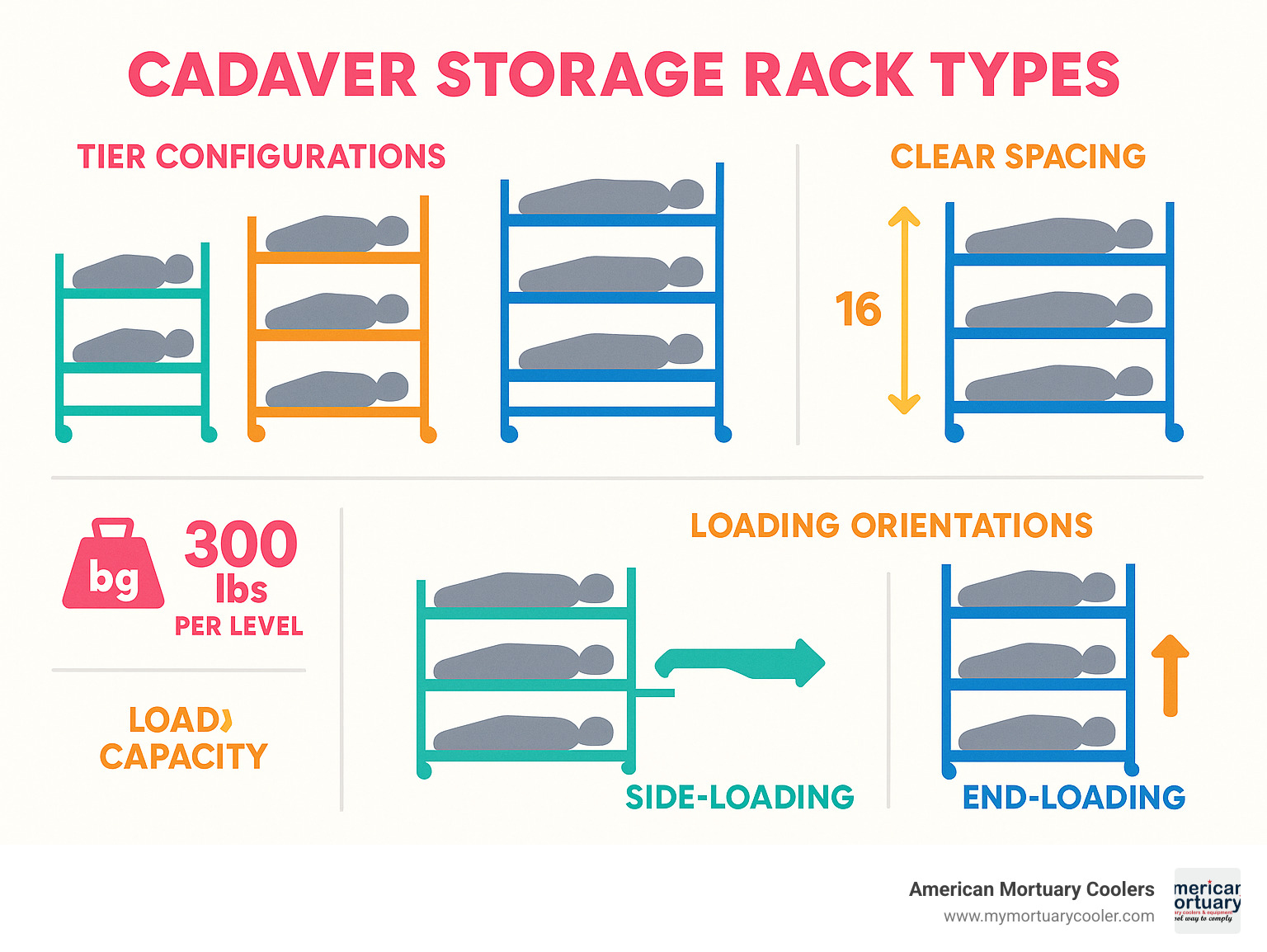
Cadaver storage racks terms to learn:
Why Proper Cadaver Storage Matters
Effective cadaver storage maintains dignity while protecting your staff and facility. Poor storage solutions can lead to decomposition issues, workplace injuries, and inefficient use of valuable cooler space.
Decomposition Control: Proper rack ventilation and temperature maintenance slow decomposition processes, extending storage time and reducing odors.
Staff Safety: Manual lifting of deceased individuals poses serious injury risks. Roller-equipped racks reduce strain by enabling one-person transfers.
Space Optimization: Vertical storage maximizes your cooler's capacity without expanding its footprint. A well-designed rack system can transform a cramped morgue into an efficient operation with room for surge capacity.
Key Factors When Selecting Cadaver Storage Racks
Choosing the right cadaver storage racks involves several key decisions. Most facilities face the same core considerations, and getting clarity on these factors makes everything else fall into place.
Your facility type shapes everything else about your rack selection. Hospital morgues need higher capacity and faster turnover, while funeral homes prioritize gentler handling and longer-term storage. Medical examiner offices deal with unpredictable surges, and anatomy labs need equipment that supports extended preservation periods.
Case volume tells the real story of what you need. You might average 3-5 cases daily, but what happens during peak periods when you're suddenly managing 15-20? We always recommend planning for those surge periods. A single 5-tier portable rack can store up to 5 bodies vertically, changing how you use your cooler space.
Floor space and door measurements matter more than most people realize. Measure everything—floor area, door widths, ceiling height, and maneuvering space. Mobile racks need room to roll, while stationary systems can tuck into corners you might not have considered.
Your refrigeration compatibility needs careful attention. Racks can't block ventilation systems or interfere with temperature sensors. Some facilities benefit from modular racks that break apart for transport through tight spaces.
Workflow patterns should be considered honestly. Do bodies typically enter from one side of your facility and exit from another? Multi-directional loading racks offer flexibility for complex workflows, while dedicated side-load or end-load systems optimize simpler patterns.
Expansion planning becomes critical during surge events. Research shows over 3,789 racking systems currently handle an estimated capacity of 14,400 remains nationwide—proof that scalable solutions are essential for community preparedness.
More info about rack selection
Load Capacity & Materials
Every tier on a standard cadaver storage rack supports up to 300 pounds—engineered to handle the vast majority of cases while maintaining structural integrity. The materials you choose determine whether your investment lasts five years or fifty.
304 stainless steel remains the gold standard. Type 304 stainless steel with 11-gauge tubing delivers superior corrosion resistance and sanitizes easily. Yes, it costs more upfront, but we're talking about equipment that can serve your facility for decades with minimal maintenance.
Powder-coated steel offers a smart middle ground for budget-conscious facilities. High-quality powder coating resists moisture and cleans well, though you might see some chipping with heavy daily use.
Corrosion resistance isn't optional in morgue environments. Your racks face constant moisture, harsh cleaning chemicals, and temperature swings that would destroy standard equipment.
Side-Load vs. End-Load Cadaver Storage Racks
This decision affects your daily workflow more than almost any other choice—and it's where facilities make costly mistakes by not thinking through their actual space and usage patterns.
Side-loading racks let bodies slide in from the side, which works beautifully in narrow prep rooms where every inch of aisle width matters. The side opening typically spans 80 inches, perfectly accommodating standard body trays up to 79 inches long.
End-loading racks require bodies to load from the end, demanding more aisle space but offering easier access for lifts and transport equipment. That end opening measures about 27 inches wide—designed to match standard tray widths perfectly.
Aisle width requirements tell the real story. Side-load systems work with approximately 4 feet of aisle width, while end-load systems need 6-8 feet for comfortable operation.
Ergonomics often tips the scales toward end-loading for staff comfort. Less awkward reaching and twisting means fewer workplace injuries and faster transfers.
Temporary vs. Permanent Cadaver Storage Racks
The choice between temporary and permanent solutions can make or break your surge capacity planning—and most facilities need both types for different situations.
Deployment speed makes temporary systems shine during emergencies. Our collapsible cadaver storage racks go from folded to fully operational in about 60 seconds, storing up to 4 bodies per rack.
Collapsible systems solve the storage puzzle neatly. They fold down compactly when not needed but expand instantly when demand spikes.
Mass fatality response scenarios demand specialized temporary solutions. Quick-deploy racks integrate seamlessly with trailer-mounted coolers and portable morgue systems.
Long-term anchoring gives permanent installations superior stability and safety. Optional seismic anchoring kits provide extra security in earthquake-prone areas.
Types, Features & Dimensions of Cadaver Storage Racks
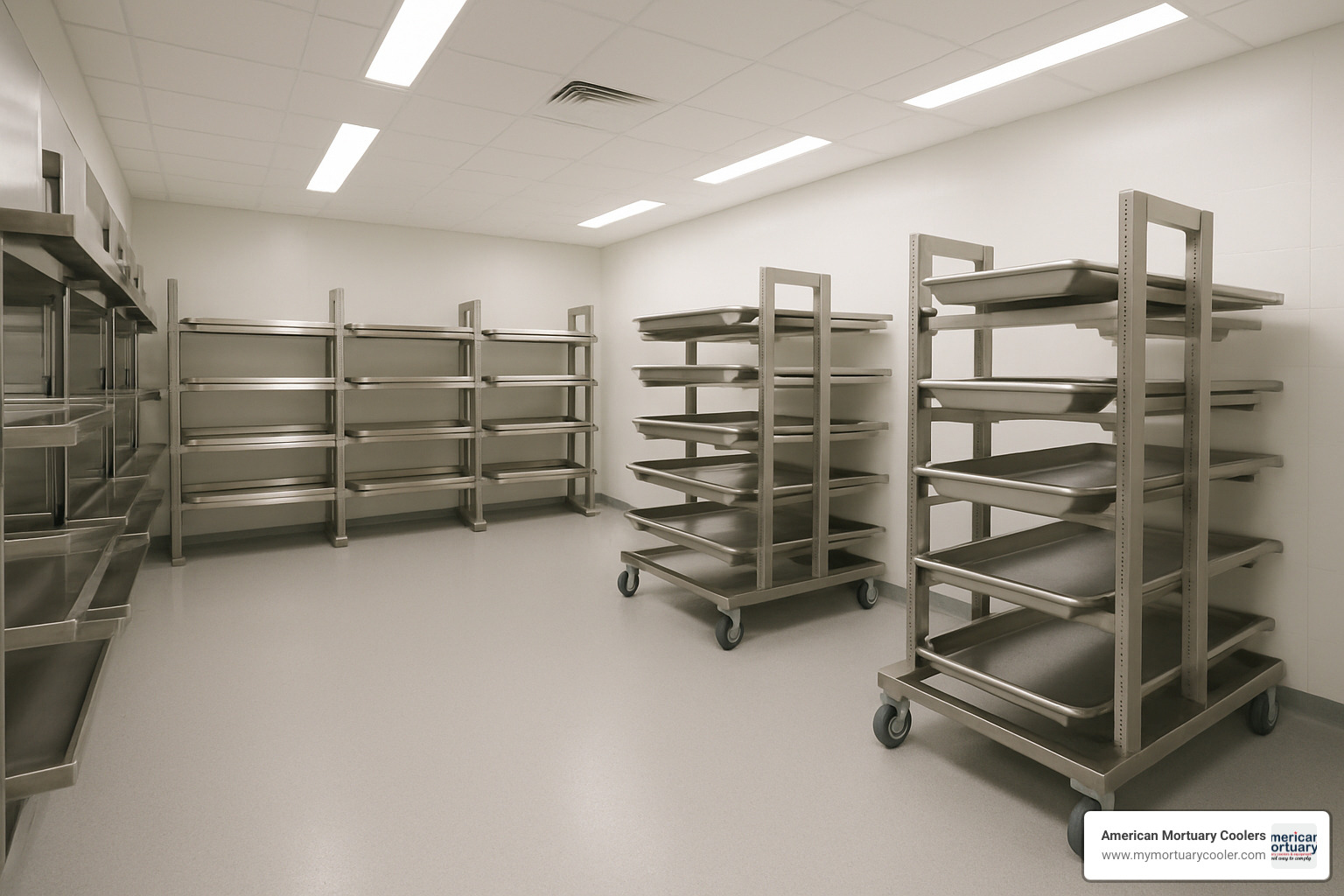
When you walk into a well-organized morgue, you'll notice how different cadaver storage racks work together like pieces of a puzzle. Each type has its place, and smart facilities often mix and match systems to create the perfect setup for their needs.
Stationary cantilever racks are the workhorses of most facilities. These fixed installations feature arms that extend from central posts, creating an open design that makes loading much easier. You can configure them with anywhere from 2 to 8 tiers, depending on your ceiling height and capacity needs.
Mobile cantilever racks give you the same solid construction but add heavy-duty casters with reliable brakes. This flexibility lets you rearrange your storage layout when case loads shift or when you need to clean thoroughly.
Collapsible systems are the Swiss Army knives of morgue equipment. These ingenious racks fold completely flat when you don't need them, then deploy in about 60 seconds when demand spikes.
The choice between refrigerated and unrefrigerated racks depends on your cooling setup. Refrigerated units have their own cooling systems and can work anywhere, while unrefrigerated racks rely on your walk-in cooler or morgue room temperature.
Multi-directional loading racks offer the ultimate in flexibility. These versatile systems accept bodies from multiple angles, which proves invaluable in tight spaces or facilities with complex workflows.
| Rack Type | Tiers | Width | Length | Load/Tier | Best Use |
|---|---|---|---|---|---|
| Portable Cantilever | 2-5 | 30" | 83" | 300 lbs | General storage |
| Stationary Roller | 3-5 | 32" | 84" | 375 lbs | High-volume facilities |
| Collapsible | 2-4 | 28" | 80" | 300 lbs | Surge capacity |
| Multi-Directional | 2-5 | 30" | 83" | 300 lbs | Flexible workflows |
Core Components & Options
The best cadaver storage racks share certain quality components that make the difference between smooth daily operations and constant frustration.
Tier configurations typically range from 2 to 5 levels, though we've built custom 8-tier systems for facilities with serious space constraints. Standard heights include 44.56 inches for 3-tier units, 62.31 inches for 4-tier, and 80.06 inches for 5-tier configurations. The math works out to about 16 inches of clear space between levels.
Nylon roller assemblies are where quality really shows. Cheap rollers bind up, make noise, and fail when you need them most. Quality ball-bearing rollers glide smoothly even under heavy loads and keep working through thousands of cycles.
Locking casters on mobile units need to be substantial—typically 6 inches in diameter with reliable braking systems. Front brakes provide the stability you need during loading operations.
Leveling pads might seem like a minor detail, but they're crucial for stability. Adjustable feet accommodate uneven floors and provide rock-solid support.
Security straps with buckles add an extra layer of safety for transport or in earthquake-prone areas.
Standard Sizes & Custom Builds
Most facilities do fine with standard dimensions, but sometimes your space or workflow demands something different.
Standard tray widths of 23, 27, and 32 inches handle the vast majority of cases. The 16-inch clear space between tiers has become the industry standard because it balances safety with capacity.
Custom bariatric units address the reality that standard sizes don't work for everyone. We regularly build racks up to 36 inches wide with reinforced construction to handle higher weight limits.
Modular construction makes life easier in several ways. Bolt-together designs mean no welding required for assembly, and you can reconfigure or relocate units as needs change.
Height considerations start with that first tier positioned about 6 inches off the floor. This height allows trolley access while keeping lifting to a reasonable level.
Benefits of Roller Racks Over Shelving
The shift from traditional shelving to roller racks represents one of the biggest improvements in mortuary equipment in recent decades.
One-person transfers change everything about staffing and scheduling. Instead of waiting for multiple people to coordinate a move, one technician can handle the job safely and efficiently.
Injury reduction alone justifies the investment for most facilities. Manual lifting of deceased individuals causes numerous workplace injuries every year, leading to workers' compensation claims, lost time, and staff turnover.
Faster turnaround means better service for families and more efficient use of your space. What used to require multiple staff members and several minutes now takes one person less than a minute to complete.
Capacity gains often surprise facility managers. Roller racks typically allow closer spacing than traditional shelving because they require less maneuvering room.
Scientific research on roller-rack ergonomics
Integrating Racks With Lifts, Trays & Coolers
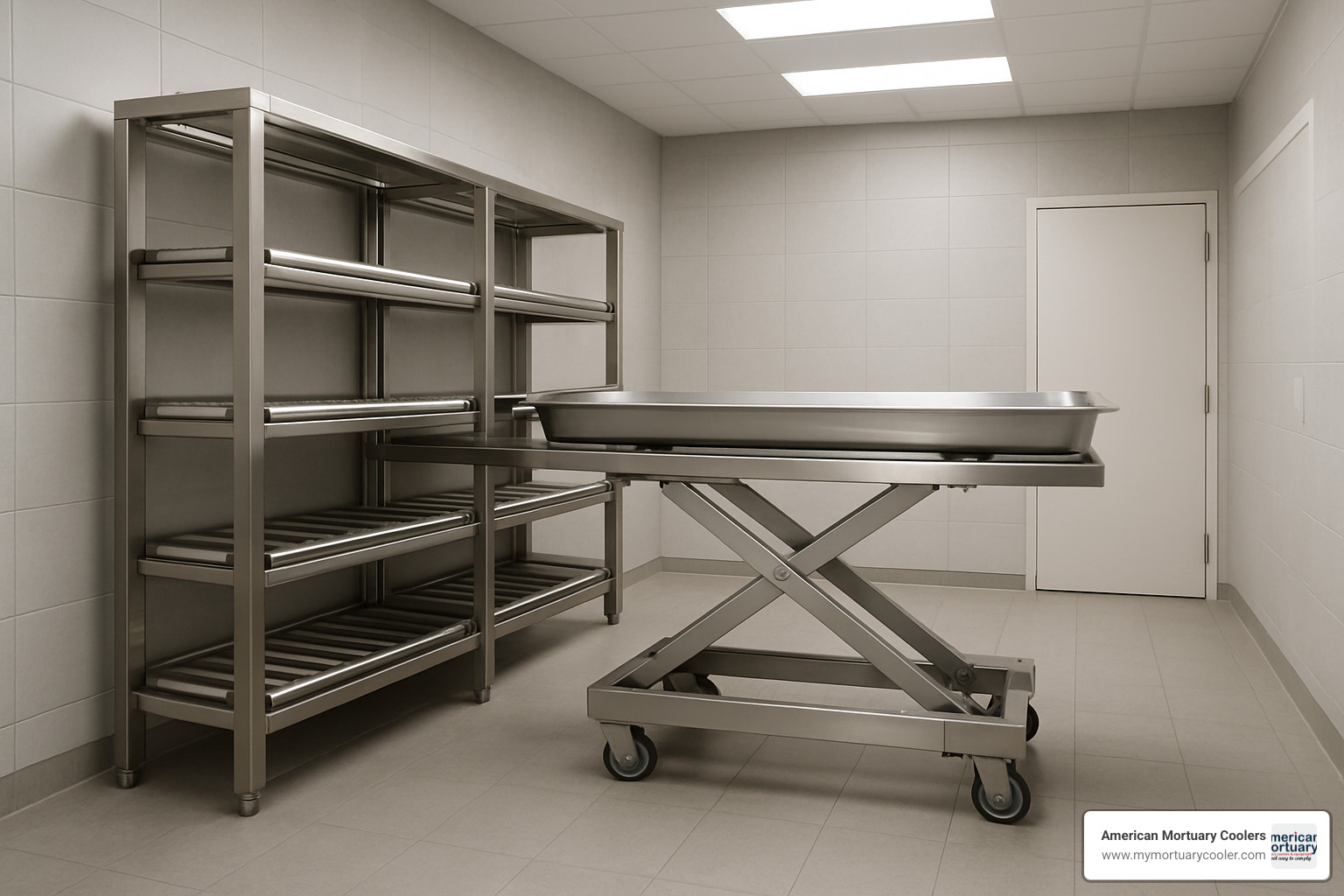
The real magic happens when your cadaver storage racks work seamlessly with your other equipment. Think of it like a well-choreographed dance—when everything moves together smoothly, your entire operation becomes more efficient and safer for your staff.
Total-roll systems represent the gold standard in mortuary workflow design. Instead of lifting and transferring bodies multiple times, these integrated setups use roller assemblies throughout your entire facility. Bodies glide effortlessly from storage racks to examination tables to preparation areas without a single manual lift.
This approach transforms how your facility operates. The scissor lifts we integrate with these systems can reach from as low as 15.25 inches all the way up to 93 inches—perfect for accessing those top tiers on a 5-tier rack system.
Body trays play a crucial role in this integration. Standard dimensions of 26 inches wide by 79 inches long fit seamlessly with most rack systems, though we regularly build custom sizes when facilities have unique requirements.
Cooler doors often become the limiting factor in rack selection. We've seen facilities order perfect rack systems only to find they won't fit through their cooler entrances. Always measure your door widths and consider swing patterns before finalizing your order.
Ventilation requirements matter too. Your cadaver storage racks shouldn't block air circulation patterns inside walk-in coolers.
More info about lift integration
Safe Loading & Unloading Best Practices
After helping hundreds of facilities nationwide, we've learned that good equipment is only half the equation. The other half is using it correctly.
One-technician workflows become possible with properly designed roller systems. This isn't just about saving labor costs—it's about reducing the coordination required between multiple staff members.
Locking brakes might seem obvious, but we've seen too many close calls from mobile racks that weren't properly secured. Always engage those caster brakes before any loading or unloading operation.
Security straps provide an extra layer of protection, particularly when moving loaded racks or in areas prone to seismic activity.
Clean rollers maintain smooth operation and prevent contamination between cases. A quick inspection and cleaning routine keeps transfers smooth and identifies any damaged rollers before they cause problems.
Surge Capacity & Mass Fatality Planning
Recent events have taught us all about the importance of surge planning. Facilities that seemed perfectly sized for normal operations suddenly found themselves overwhelmed when demand spiked unexpectedly.
Portable mortuary storage racks can increase your existing cooler capacity by up to 400%. That's not a typo—proper vertical storage can quadruple your capacity without expanding your cooler's footprint.
Quick-deploy racks store compactly when not needed but expand rapidly when demand increases. These collapsible systems can be set up in under 60 seconds, changing available floor space into organized storage capacity.
Trailer coolers equipped with rack systems provide temporary capacity anywhere you need it. These mobile units prove invaluable during mass casualty events, facility maintenance periods, or when your main cooler needs repairs.
Response-ready kits include everything needed for immediate deployment—racks, compatible trays, security straps, and assembly tools.
The Mass Fatality Response community has documented over 3,789 racking systems in use nationwide, with an estimated total capacity of 14,400 remains.
Scientific research on surge systems
Cost, Maintenance & Compliance Considerations
When you're investing in cadaver storage racks, you're making a decision that will impact your facility for decades to come. I've seen too many facilities choose the cheapest option upfront, only to spend more money later on repairs, replacements, and lost productivity.
The reality is that quality rack systems pay for themselves over time. A basic portable rack might start around $955, while a sophisticated multi-tier roller system can run over $4,000. That price difference might seem steep initially, but consider this: a well-built stainless steel rack can serve your facility for 20+ years with minimal maintenance.
Lifecycle costs tell the real story. That $955 rack might seem like a bargain until you factor in the hidden expenses. More frequent cleaning due to inferior materials, higher maintenance costs from worn components, and the productivity losses from equipment downtime all add up quickly.
CDC and OSHA compliance isn't optional—it's the foundation of safe operations. Your racks must meet load ratings (typically 300 lbs per tier), use appropriate materials for sanitary environments, and provide ergonomic loading heights that protect your staff.
For facilities in earthquake-prone areas, seismic anchoring provides peace of mind at a relatively small additional cost.
Cleaning & Disinfection
Keeping your racks clean isn't just about appearance—it's about extending their lifespan and maintaining the dignified environment your families deserve.
Stainless steel surfaces are the gold standard for a reason. They resist most disinfectants and maintain their appearance with proper care. However, avoid chloride-based cleaners—they can cause pitting and corrosion even in high-quality stainless steel.
Your disinfection schedule should match your facility's usage patterns. High-volume morgues might need daily cleaning, while smaller funeral homes could get by with weekly deep cleaning. The key is consistency—irregular cleaning allows buildup that becomes harder to remove over time.
Don't forget about caster maintenance. Those wheels and brakes take a beating, and debris can accumulate in the mechanisms. Regular inspection prevents small problems from becoming safety hazards.
Budgeting & ROI
Smart facility managers think beyond the purchase price to consider the total return on investment. Quality cadaver storage racks often generate savings that justify their higher initial cost within just a few years.
Sometimes adding racks provides more value than expanding cooler space. Before you start planning that expensive cooler addition, calculate how much additional capacity you could gain with better rack systems.
Labor savings represent the biggest return on investment for most facilities. Roller racks enable one-person operations where you previously needed two staff members. Over time, this translates to significant payroll savings and greater scheduling flexibility.
Modular systems grow with your needs instead of becoming obsolete. When your case volume increases, you can add components rather than replacing entire systems.
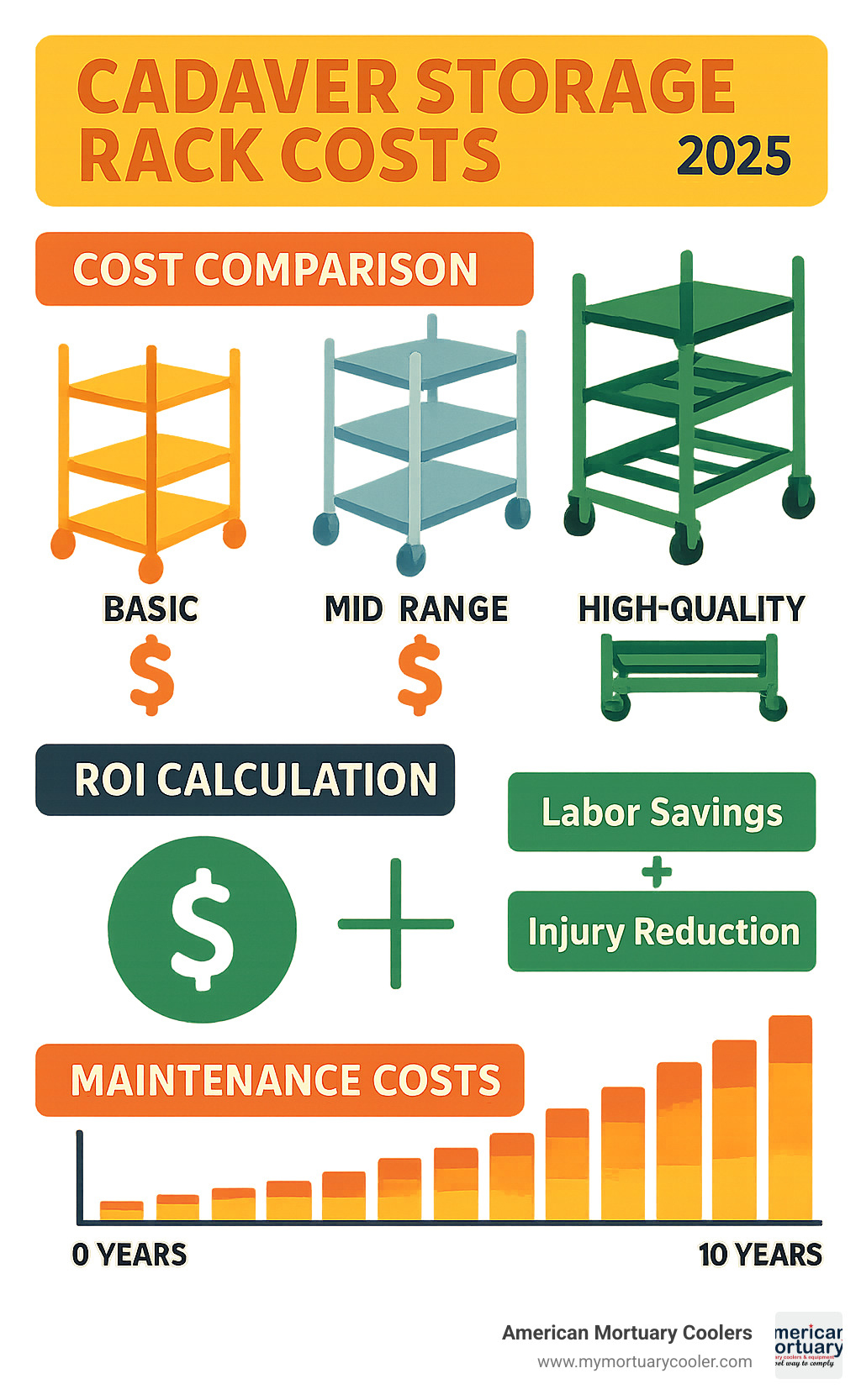
Frequently Asked Questions about Cadaver Storage Racks
We get these questions almost daily from funeral directors and morgue managers across the country. After helping hundreds of facilities choose the right storage solutions, we've learned that the same concerns come up again and again.
What dimensions fit most standard coolers?
Most cadaver storage racks are designed with standard cooler sizes in mind. Our typical portable units measure 30 inches wide by 83 inches long, which fits comfortably through standard 36-inch cooler doors with several inches to spare on each side.
But here's what we've learned from experience—always measure twice, order once. While most coolers follow industry standards, older installations or custom builds can surprise you.
Measure these key dimensions before ordering:
- Door opening width and height
- The pathway from door to final location
- Any obstructions like shelving, pipes, or equipment
- Ceiling height if you're considering multi-tier systems
Don't forget about door swing patterns either. Some coolers have doors that swing into the storage area, reducing your effective opening width. We always recommend having at least 2 inches of clearance on each side for easy maneuvering.
How many tiers can my facility safely operate?
This question really comes down to your staff's safety and your available equipment. Without any mechanical lifting assistance, we strongly recommend sticking to 3-tier systems maximum. The math is simple: the first tier sits 6 inches off the floor, then each additional tier adds 16 inches of clear space plus the tray thickness.
With a 3-tier system, your highest storage level sits at about 38 inches—still manageable for most staff members. Go higher than that, and you're asking people to lift heavy loads above shoulder height, which is a recipe for injury.
If you have scissor lifts or hydraulic equipment, 5-tier systems become perfectly safe. Our battery-powered lifts can reach up to 93 inches, giving you access to even the highest tiers without strain.
It's not just about reaching the tiers—you need enough vertical clearance above each level to safely maneuver bodies in and out. That 16-inch spacing isn't arbitrary; it's based on real-world ergonomics and safety requirements.
Do I need refrigerated or unrefrigerated racks?
The answer depends entirely on your facility's setup and how long you need to store remains. Most facilities we work with choose unrefrigerated racks because they already have walk-in coolers or climate-controlled morgue rooms providing the necessary cooling.
Unrefrigerated racks work great when:
- You have adequate walk-in cooler space
- Your morgue room maintains proper temperatures
- You're storing bodies for 24-72 hours typically
- You want to maximize your existing cooling investment
Refrigerated racks make sense when:
- You lack adequate cooler space for your volume
- You need temporary storage solutions for surge events
- You're setting up satellite locations without permanent cooling
- You require longer-term storage capabilities
Refrigerated racks cost more upfront and require ongoing maintenance, but they give you incredible flexibility. We've seen facilities use them for overflow during busy periods, then move them to different locations as needs change.
For most funeral homes handling typical volumes, unrefrigerated racks in existing coolers provide the best value. Medical examiner offices and high-volume facilities often benefit from the flexibility that refrigerated units provide.
Conclusion
Choosing the right cadaver storage racks comes down to understanding your facility's daily reality. We've seen funeral homes transform their operations with the right equipment, and we've watched others struggle because they chose based on price alone rather than their actual needs.
The facilities that succeed think beyond today's requirements. They consider surge capacity, staff safety, and workflow efficiency. They understand that a quality rack system isn't just storage—it's an investment in their team's wellbeing and their facility's reputation.
At American Mortuary Coolers, we've spent over a decade helping facilities across Tennessee, Georgia, Illinois, South Carolina, Texas, California, New York, and Pennsylvania solve their storage challenges. Every facility is different, but the fundamentals remain the same: proper storage protects dignity, ensures safety, and maximizes efficiency.
The numbers speak for themselves. Facilities with roller-equipped cadaver storage racks reduce workplace injuries, speed up transfers, and often increase capacity by 400% without expanding their cooler footprint. That's not just operational improvement—that's change.
Whether you need collapsible systems for surge planning or permanent installations for daily operations, the key is choosing equipment that grows with your needs. The racks you install today will serve your facility for decades. Make sure they're built to last and designed for your specific workflow.
Quality matters in this industry. Your staff deserves equipment that makes their job safer and more efficient. The families you serve deserve the dignity that comes from proper storage systems. And your facility deserves the reliability that comes from working with experienced manufacturers who understand your challenges.
Ready to improve your storage capacity and workflow efficiency? We're here to help design custom solutions that fit your space, your budget, and your needs. From Tennessee to California, we deliver durable cadaver storage racks that funeral professionals trust.
